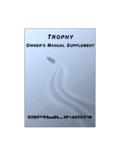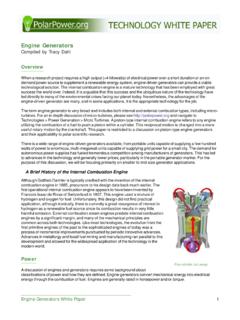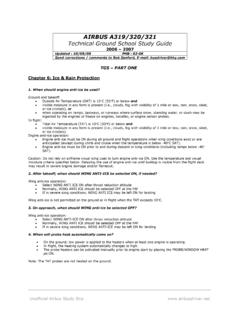Transcription of ASTON MARTIN
1 ASTON MARTIN A PRODUCT OVERVIEW Part lll After David Brown: Tadek Marek s V8 and Beyond 2 Bibliography With thanks to ASTON MARTIN V8 Michael Bowler Cadogan Publishing ASTON MARTIN & Lagonda David G Styles The Crowwood Press ASTON MARTIN Buyers Guide Paul R Woudenberg Motorbooks International ASTON MARTIN V8s F Wilson McComb Osprey Auto History ASTON MARTIN Gold Portfolio R M Clarke Brooklands Books ASTON MARTIN Road Tests Adrian Feather The Scolar Press ASTON MARTIN Dudley Coram Motor Racing Publications AMOC Registers AMOC The Most Famous Car David Worrall Solo Publishing in the World ASTON Journal of the ASTON ASTON MARTIN Heritage MARTIN Heritage Trust Trust Power, Beauty and Soul David Dowsey Peleus Press 3 I have been working in the world of ASTON MARTIN for the past 25 years. I came upon the marque in my general course of business in the motor trade and have become as enthusiastic as my customers about ASTON MARTIN and their products.
2 My son Matthew and I with my first ASTON MARTIN There is an aura about ASTON MARTIN , a heritage far beyond simple statistics. Winning at Le Mans, victory in the World Sportscar Championship, the Zagatos and Royal patronage would be enough for any car manufacturer. ASTON MARTIN goes beyond that every car has its character and every owner, real pride in his or her car. Any market place has pitfalls for the unwary and opportunities for the unscrupulous. What I have tried to produce is an overview of ASTON MARTIN cars that can act as an introduction to the marque. It is my view, coloured by my experiences and the use of my library of ASTON MARTIN books as a reference. Most of the ASTON MARTIN photos are from my own archive and I have been fortunate enough to enjoy handling each of these glorious cars. This may represent your first foray into the world of ASTON MARTIN ; it may supplement your own knowledge.
3 Whatever your point of reference, I hope this overview adds to your enjoyment. Philip Jones Byron International 4 THE ASTON MARTIN DBS Production dates: October 1967 May 1972 Top Speed: 148 mph Acceleration: 0 60 in seconds, 0 100 in seconds Chassis numbers: DBS/5001/R DBS/5829/RC (39 of these numbers not used) Team car chassis no: Length 15 feet inch (4580 mm) Width 6 0 ( m) Height 4 feet 4 inches (1330 mm) Ground clearance 5 inches (140 mm) Track Front 4 11 (1500mm) Rear 4 11 (1500mm) Wheelbase inches (2610mm) Turning circle 36 0 inches (1097 cm) Dry weight 3500 pounds (1588 Kg) Engine 4 litre Capacity 3,995 cc Cylinder bore 96mm (stroke 92mm) Compression ratio.
4 1 Power output 282 bhp @ 5500 rpm Carburettors 3 x SU HD8 Chassis Square section tube frame, aluminium body. Transmission 5 speed synchromesh Clutch Borg & Beck 9 inch plate Front suspension 2 unequal wishbones and coil springs co-axial shock absorbers Anti roll bar Rear suspension Coil springs, de Dion axle, trailing links and Watts linkage Selectaride shock absorbers Steering Rack and pinion Brakes Girling disc with separate servo assistance inch disc front inch disc rear 1970 ASTON MARTIN DBS Chassis DBS/5554/R BYRON INTERNATIONAL 5 In December 1965, the policy committee at ASTON MARTIN rejected the Touring proposals for a new model and in January 1966 decided to commission what it described as a 170 mph two seater. Despite the rejection of Touring s four seater proposal, they were approached again with the idea of a car on a shortened DB6 chassis with a de Dion axle and powered by the forthcoming ASTON MARTIN V8.
5 The target date was given for the Paris and London Shows on 1967 and the target was duly met almost the cars shown had their doors locked shut on the show stands because they were incomplete. They never made the market and were finished at Newport Pagnell and sold to understanding enthusiasts. While Touring were working to their brief, William Towns was supplementing his hard work on DB6 interiors with developing his own ideas for the new model. With the same target as Touring for the motor shows of late 1967, the chosen design was engineered by Bert Thickpenny and his team with the model completed by July. Early wind tunnel results were not encouraging and neither was progress on the V8 engine. Tadek Marek had three engines running by June 1965 two on test beds and one under the bonnet of a heavily modified DB5. The only difficulty with these were the connecting rods and Tadek quickly ironed out that problem and built another three units.
6 Running these, they hit a more fundamental problem heads were distorting and liners were fretting. Further development came with an association with Lola and two of its T70 s were entered into Le Mans with ASTON MARTIN V8 s with the disastrous outcome of neither car finishing and it revealed that there was a major issue with main bearing housing failure. By now it was June 1967 and launch was only 3 months away and the decision was made to launch the DBS with the current DB6 4 litre Vantage engine. By way of comparison, for the DBS, the rigid steel platform chassis of the DB6 was widened by 4 inches and the wheelbase lengthened by 1 inch to allow the engine to be dropped behind the front cross-member. As well as the inclusion of the de Dion back axle, roller splines were used on the shafts on a British production car for the first time. Located by trailing arms and Watts linkage, it was suspended by coil springs and dampened by double acting Armstrong Selectaride shock absorbers.
7 It was a structure that promised outstanding handling and reflected a long line of development within ASTON MARTIN cars. The car had many of the up to date features incorporated in the DB6 dashboard warning lights, red lights on the trailing edge of the doors, Sundym glass, electric windows and heated rear window. The petrol tank had a capacity of 21 gallons which included a 3 gallon reserve and the front end of the car was distinguished by the four 5 inch quartz iodine headlights. In spite of the inauspicious portent of the transporter taking the new DBS to the Paris Show being involved in a crash, things went well for the white finished car. It was also displayed at the London Motor Show and was equally well received, the only criticism coming from the width of the car. At six feet wide, it was a full six inches wider than the DB6 it was even one inch wider than a Rolls Royces Silver Shadow - as it had been designed to take the V8 engine.
8 At an asking price of 5,449, the ASTON MARTIN DBS was 1,382 more than a DB6, which continued on in production. It was far more luxurious, much closer to a proper four seater and, with the de Dion axle, a much better handling car. However, the car had been designed for the more powerful V8 engine and carried 179 kilograms more weight than the DB6 which, as a consequence, outpaced its new stable mate in acceleration and top speed. All it needed was for the V8 engine to be fully 6 THE ASTON MARTIN DBS V8 Production dates: April 1970 May 1972 Top Speed: 162 mph Acceleration: 0 60 in seconds, 0 100 in seconds Chassis numbers: DBSV8/10001/R DBSV8/10405/RCA Team car chassis no: Length 15 feet inch (4580 mm) Width 6 0 ( m) Height 4 feet 4 inches (1330 mm) Ground clearance 5 inches (140 mm) Track Front 4 11 (1500mm) Rear 4 11 (1500mm) Wheelbase inches (2610mm) Turning circle 38 0 inches (1158 cm) Dry weight 3800 pounds (1727 Kg) Engine litre Capacity 5,340 cc (326 cu.)
9 Inch) Cylinder bore 100mm (stroke 85mm) Compression ratio :1 Power output *310 bhp @ 5000 rpm Carburettors N/A Fuel Injection Bosch Fuel Injection Chassis Square section tube frame, aluminium body. Transmission 5 speed synchromesh Option of Chrysler Torqueflite 3 speed automatic Clutch Borg & Beck 10 inch plate Front suspension 2 unequal wishbones and coil springs co-axial shock absorbers Anti roll bar Rear suspension Coil springs, de Dion axle, trailing links and Watts linkage Selectaride shock absorbers Steering Rack and pinion Brakes Girling disc with separate servo assistance inch ventilated disc front inch ventilated disc rear 1 inch thick discs with total swept area of 468 sq in. *Power outputs were not published originally estimates vary from under 300bhp to 375 bhp.
10 All that conjecture does not take away the fact that the DBSV8 was a very powerful car! 7 The first ASTON MARTIN DBS V8 rolled off the Newport Pagnell production line on 19th September 1969. For Tadek Marek it was the public debut for his new engine and the car received a rapturous welcome from the public. The engine used the same light aluminium alloy construction as the old straight six and used a similar design for the valve gear employing two chain driven overhead camshafts per cylinder bank and two valves per cylinder. The 8 wet liner cylinders were in a V formation set at 90 degrees with fuel and air were supplied via a Bosch mechanical fuel injection system with the injector pump in the middle of the cylinder vee and eight separate throttle butterflies mounted outboard of each induction port. The engine had five main bearings and the cooling system was with thermostat, water pump and viscous-coupling fan.







